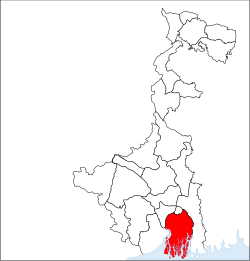South 24 Parganas
|
South 24 Parganas district দক্ষিণ চব্বিশ পরগণা জেলা |
|
|---|---|
| District of West Bengal | |
 Location of South 24 Parganas district in West Bengal |
|
| Country | India |
| State | West Bengal |
| Administrative division | Presidency |
| Headquarters | Alipore |
| Government | |
| • Lok Sabha constituencies | Jaynagar, Mathurapur, Diamond Harbour, Jadavpur, Kolkata Dakshin |
| • Assembly seats | Gosaba, Basanti, Kultali, Patharpratima, Kakdwip, Sagar, Kulpi, Raidighi, Mandirbazar, Jaynagar, Baruipur Purba, Canning Paschim, Canning Purba, Baruipur Paschim, Magrahat Purba, Magrahat Paschim, Diamond Harbour, Falta, Satgachia, Bishnupur, Sonarpur Dakshin, Bhangar, Kasba, Jadavpur, Sonarpur Uttar, Tollyganj, Behala Purba, Behala Paschim, Maheshtala, Budge Budge, Metiaburuz |
| Area | |
| • Total | 9,960 km2 (3,850 sq mi) |
| Population (2011) | |
| • Total | 8,153,176 |
| • Density | 820/km2 (2,100/sq mi) |
| • Urban | 1,089,730 |
| Demographics | |
| • Literacy | 78.57 per cent |
| • Sex ratio | 937 |
| Major highways | NH 117 |
| Average annual precipitation | 1750 mm |
| Website | Official website |
South 24 Parganas (Pron: pɔrɡɔnɔs) is a district of West Bengal State, headquartered in Alipore. It is the largest district of West Bengal State by area and second largest by population. On one side it has the urban fringe of Kolkata and on the other, the remote riverine villages in the Sundarbans.
It is the sixth most populous district in India (out of 640).
Once the capital of Raja Bikramaditya and Maharaja Pratapaditya was at Dhumghat. Later it was transferred to Ishwaripur (Originated from the name Jeshoreshwaripur). Maharaja Pratapaditya declared independence of South Bengal (Jessore, Khulna in north, Sundarbans, Bay of Bengal in South, Barisal in east and River Ganges in west) against the Mughal Empire of India.
Jashoreshwari Kali Temple (built by Pratapaditya), Chanda Bhairab Mandir at Ishwaripur (a triangular temple, built during the Sena period), Five domed Tenga Mosque at Banshipur (Mughal period), two big and four small domed Hammankhana (constructed by Pratapaditya) at Bangshipur, Govinda Dev Temple at Gopalpur (built by Basanta Roy, uncle of Maharaja Pratapaditya in 1593), Jahajghata Port (Khanpur). Pratapaditya king of Jessore and one of the bara-bhuiyans of Bengal. Pratapaditya fought against the Mughal imperial army during its inroad into Bengal in the early 17th century. His father Shrihari (Shridhar), a Kayastha, was an influential officer in the service of daud khan karrani. On the fall of Daud he fled away with the government treasure in his custody. He then set up a kingdom for himself in the marshy land to the extreme south of Khulna district (1574) and took the title of Maharaja. Pratapaditya succeeded to the kingship in 1574. The baharistan and the travel diary of Abdul Latif and the contemporary European writers, all testify to the personal ability of Pratapaditya, his political pre-eminence, material resources and martial strength, particularly in war-boats. His territories covered the greater part of what is now included in the greater Jessore, Khulna and Barisal districts. He established his capital at Dhumghat, a strategic position at the confluence of the Jamuna and Ichhamati.
...
Wikipedia
